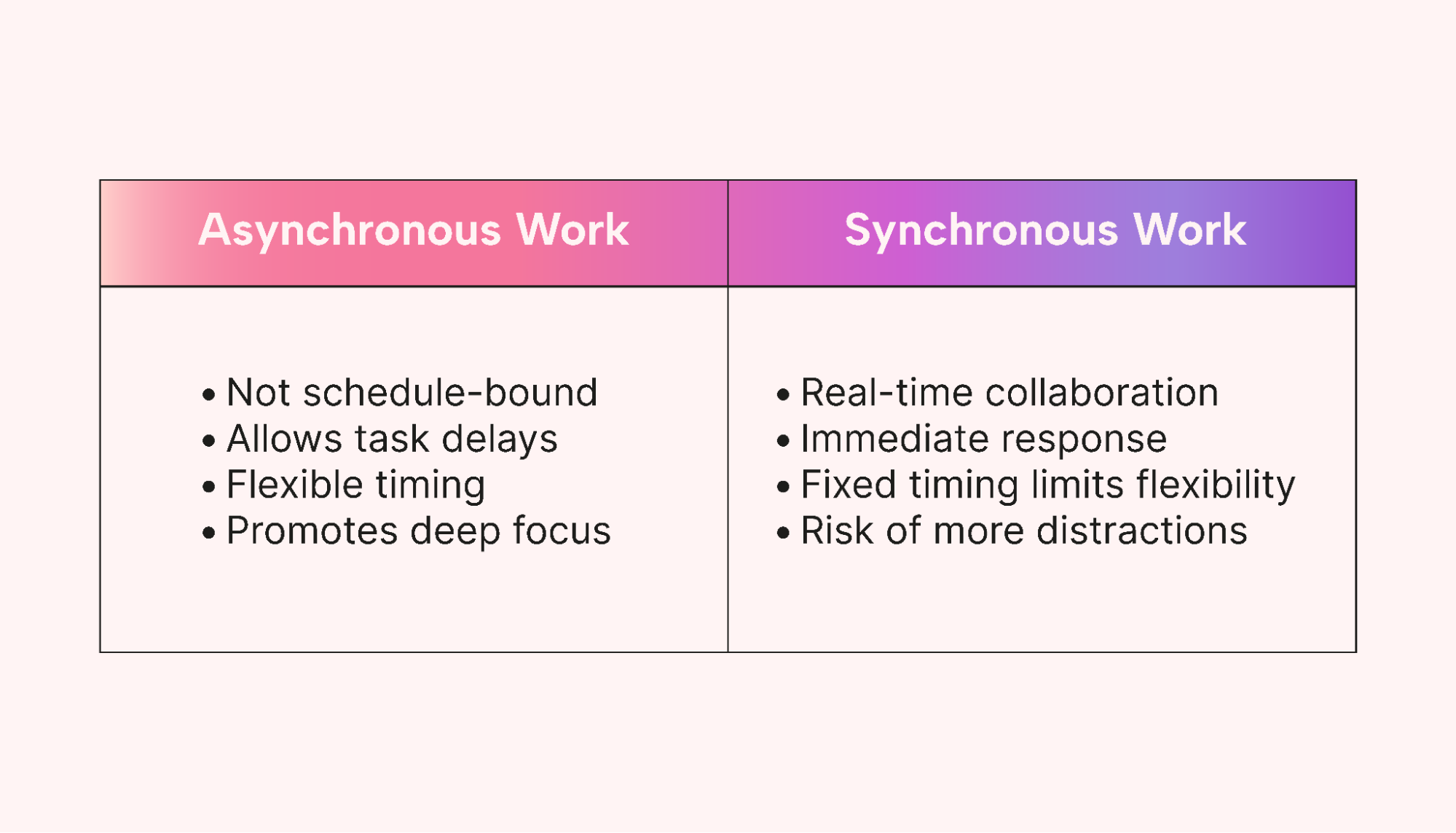At home and work, we use many ways to communicate and collaborate with our family, friends, and colleagues.
However, using different systems can complicate collaboration because data often ends up all over the place (and in different formats).
Fortunately, collaboration systems can help.
A collaboration system supports decision-makers by providing access to document sharing, knowledge, expertise, ideas, and resources. It does this all in real-time and on a centralized platform, streamlining workflows, reducing duplication, and encouraging teamwork.
Let’s get into more about these systems and how they can help your business.
Why do we need collaboration systems?
It's a complicated world, and things can easily fall through the cracks — especially when your team is spread across the world.
But online collaboration tools can help you mind those cracks.
These systems let your team members work remotely or across different time zones, making it easier for you to accommodate diverse work styles and schedules. They also provide an effective mechanism for the exchange of ideas and perspectives. This leads to better decision-making and problem-solving (and a more inclusive work environment).
Collaboration systems have revolutionized the way we work. They've transformed our offices from rigid "9–5" physical places into dynamic, interconnected digital spaces.
In short, collaboration tools are essential for navigating and succeeding in today's digital age.
Types of collaboration
There are two broad collaboration categories: synchronous and asynchronous. But that doesn’t mean you must use one or the other. Instead, you can use a hybrid system to provide cross-functional collaboration across different teams and disciplines.
Here’s a brief review of synchronous, asynchronous, and cross-functional collaboration:
Synchronous
When your collaboration software is configured to be synchronous, it operates in real-time mode rather than in a store-and-forward manner, like email.
In a synchronous collaboration environment, everyone participates at the same time. This type of conversation is helpful at times, such as if you are trying to get real-time responses from your team or an emergency happens that requires immediate discussion and action.
Synchronous collaboration is also preferred when the subject can be interpreted in several ways or is very detailed or complex.
Asynchronous
More conventional collaboration systems don’t provide real-time communication. Instead, they’re configured to store messages and wait for the recipient to retrieve them. Common examples include email or message boards.
With asynchronous communication, you expect a delay in response, sometimes lasting days or (even) weeks. Team members will consume and engage with the content at a time that’s convenient for them. They’ll also jump in and out of the conversation as other things take their attention away.
This kind of communication gives your team a chance to think about their responses rather than react in real-time.
Cross-functional
A cross-functional team begins when you put people from multiple areas of a business into a single team. A key advantage of this is better access to resources, more diverse perspectives, broader skill sets, and new ideas.
But this approach has disadvantages, too — mostly in communication, where the biggest challenge is often the participants’ terminology. For example, a team member from finance may use jargon that’s unfamiliar to their colleagues on the software development team, and vice versa.
A great way to ensure cross-functional collaboration is effective is to combine asynchronous and synchronous collaboration and use a store-and-forward method.
Let’s say a finance executive in your business posts or emails a note to the team. If anything is unclear to the team members, you can schedule a synchronous meeting to help everyone get on the same page.
Enterprise collaboration
No matter the size of the business, the basics remain the same: collaboration is a system of communications that allows for better information gathering and knowledge sharing among employees. Specifically, it lets them interact and communicate beyond their typical department-based work environments.
The complexity goes up a notch with enterprise collaboration, however, because enterprise collaboration encompasses multiple solutions.
For instance, it may need to include your company intranet, your email address, a cloud phone system, your team messaging platform, video conferencing, and other communication mechanisms, such as social media.
Collaboration technology
Technology is a massive part of most of our lives, both at work and at home. Just think about your family. Most of them have a mobile phone. And on that one device, they talk to other people and exchange messages via text, email, social media, etc.
It’s the same at work, but with other communication tools and apps added into the mix.
But the tools don’t always “talk” to one another, which is why we need collaboration technology.
The goal of collaboration technology is to strengthen communication and bring your team members closer together, even if they’re far away from each other. It’s also intended to break down barriers in hybrid teams, allow for interactions regarding various team issues, and help the team work together more efficiently on projects.
Choosing a collaboration tool
There's a lot to consider when choosing the right online collaboration tool for your business. Needed features will vary from business to business (and even project to project).
Integration
You already have numerous communication tools in your business. So, your first step should be to consider which of them is critical and, therefore, must be integrated with your collaboration solution. Hopping apps can be a true momentum and time-killer.
Sharing documents
While sharing documents might be an obvious required feature, it’s often overlooked.
Sharing is more than simply passing a copy of a document around. Everybody must be able to make changes to it, and all the changes should be tracked so that you know who added what.
The good news is that solutions like Google Drive and Google Docs already have this functionality.
Project management
Project planning and tracking tools are a must in a collaboration system. The system should also offer Agile tools for task management, such as Kanban or Scrum.
Project managers need to be able to view the project in a way that makes sense to them (and the team).
Resource tracking
Resource tracking is critical during projects. The last thing you want to do is schedule work when critical resources are being used for other critical tasks.
The good news is that there are external resource management tools you can use.
Reporting and dashboards
Businesses and projects always have external stakeholders. One of the best ways to keep stakeholders in the loop on the business or a specific project's progress is through reporting and dashboards.
 |
Remember that everyone, from the team to external stakeholders, is busy, so they need an easy way to check progress (when needed).
6 great collaboration systems
There are many tools available that enable collaboration in your organization. We picked out six somewhat specialized ones for you to consider.
1. Motion
Motion’s most notable feature is its artificial intelligence. These allow it to plan and optimize your schedule automatically according to your tasks, projects, and online meetings.
Motion also lets you collaborate in real-time across many devices and platforms. This means your team members can stay on the same page no matter where or what devices they use.
An intuitive interface makes it easy for team members to join online meetings, share documents, communicate efficiently, and get work done. The platform integrates with several SaaS products and third-party apps, including Google Calendar, Zapier, Zoom, and Slack.
Pros
- AI functionality acts as a personal assistant
- Real-time collaboration capabilities
- Mobile and desktop app for Windows, Mac, iOS, and Android.
Cons
- Mobile and tablet experiences aren’t optimized
- Limited to auto-scheduling tasks only four weeks in advance
2. Figma
When it comes to collaboration, one size doesn't fit all. If your business or project involves design, you need a tool that can support the creative process.
Figma is such a tool, helping your team stay connected throughout the design process. It also supports brainstorming on a whiteboard and designing and testing ideas in one place.
Pros
- Very easy to use, even without extensive design knowledge
- Entirely web-based, although apps are available
- Handy for showcasing your team’s design ideas.
Cons
- No support for 3D designs or layouts
- Can’t be used offline
3. Wrike
The creative process isn’t limited to graphical work. Sometimes, you need something that can manage the proofing and approvals process for a team of content creators.
Wrike is an enterprise collaboration and project management tool with lots of flexibility and customization possibilities.
Pros
- Useful for creating or customizing workflows, dashboards, and request forms
- The approvals feature creates a paper trail of approved work
- Integrates with over 400 other solutions
Cons
- Can be overwhelming for new users
- Lacks real-time chat and video call functionality
4. Google Workspace
When you take a conventional desktop office suite, add steroids, and stick the whole thing online, Google Workspace is what you get.
This system includes productivity and real-time collaboration tools, including email, cloud storage, word processing, video and voice conferencing, team messaging, presentation tools, and shared calendars.
Pros
- Scalable and easily managed across devices
- Beginner-friendly
- Allows collaboration across the product suite
Cons
- Some limitations in terms of integration and customization
- Google support is lacking
5. Miro
Online conferencing problems include stalling and interruptions by team members becoming distracted by irrelevant things.
This is where Miro can help your team.
Miro is an online whiteboard tool that works on any device. It keeps you updated as you go along, tracking changes, assigning tasks, and supporting your conversations with team members.
You can also share screens and present your whiteboards in real time, boosting your opportunities for real-time collaboration.
Pros
- Offers a wide range of templates
- Keeps confidential and sensitive data safe
- Allows facilitators to control the flow of the discussion
Cons
- Lacks seamless integration with popular calendar tools
- Very difficult to collaborate in it when using a trackpad
6. Smartsheet
As suggested by its name, Smartsheet is a collaboration tool designed around spreadsheets. It allows you to import existing spreadsheets or create them from scratch — then, it helps you visualize the data in various ways: card, Gantt, calendar, or grid.
Smartsheet features powerful automation, along with content collaboration and commenting — which also includes running polls. It also has a no-code app-building platform and an Excel-like interface, making it easy for anyone with Excel experience.
Pros
- Very effective scheduling and task management functionality
- Has a wide range of templates, particularly for project management
- Offers a responsive and helpful Smartsheet community
Cons
- Limited integration and customization
- Minimal exporting options
5 quick tips to make the most of your collaboration system
As bad as the COVID-19 pandemic was, it was also good. It allowed us to finally use — really use — all the online tools we've created over the past few decades. And in the process, we learned what worked and what didn't, especially regarding remote collaboration.
We formulated the learnings into the following tips, some of which are summed up in an academyEX article:
- The KISS (keep it simple, stupid) principle.
- Never forget a face, a.k.a. use video often.
- Set clear expectations for your team.
- Get visual by sharing whiteboards, presentations, etc.
- Check-in with your team regularly.
How Motion can help
There are many online team collaboration tools to collaborate and communicate better. Just as every team is different, each tool has features that work well for different teams and workspaces.
To get the best out of your team, use enterprise collaboration tools that fit your particular needs and goals.
For example, if your business takes on complex projects requiring automated planning, project management, and task scheduling, Motion has what you need for effective team collaboration.
Motion makes collaborative work intuitive through AI-powered and streamlined features, such as task automation, progress tracking, and real-time communication. And the best part is that you can check it out for free. Start your 7-day free trial now!








